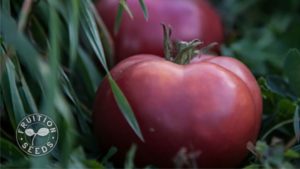I thought how the middle of winter would be the perfect time to share with you a little bit more about the difference between hot composting and cold composting. So first things first, right from the top, hot composting, super effective super fast, you’re gonna have tons of amazing compost in a matter of weeks, certainly months. it takes a lot more maintenance though cold composting, super simple, crazy easy, and it might take months, but it’ll likely take years to get lots of really nice compost, but you’ll have done almost nothing. So I’ll tell you a little bit more about the two. Hot Composting is a pretty curated process, the more material you like material you have the better and you really want to honor that two to one carbon, nitrogen, two to one brown to green ratio, the more precise those ratios are, the better they’re going to be breaking each other down, and the faster they’ll do it. So you also want to be managing your temperature. So compost thermometers are really important. They don’t cost that much. And you really want to use a compost thermometer as opposed to something you’d tuck in your chicken because you really want to get feet a couple three feet down into your compost pile, not just four inches. So you really want to have your compost pile generating basically steam. I mean that’s of one 141 degrees to 155 degrees is that magical number that is going to kill weed seeds kill pathogens, but it’s not going to be destroying and like turning your nitrogen into atmospheric nitrogen. Once your if you do have a compost that is turning really fast and is generating heat above 180. At that point, you actually do want to turn it more and add some more material to cool it down. Add some more moisture. And because of that 180 degrees, you’re kind of shooting yourself in the foot. A lot of those nutrients that you want to be encapsulating in organic matter are going to be heading into the atmosphere. So in hot composting, you definitely want to be managing temperature. And if you have a ton of material, especially if you’re chopping it up before you put it in your compost, it’s going to be turning so fast. And this is where like industrial composters they’ll take raw materials and three, four weeks later, they’ll have a gorgeous black compost with no trace of what the original sources were. But that so that’s like industrial scale, like turning compost with bulldozer style. But even at a home scale, if you’re managing it well in six months, you can easily have tons of awesome compost. So that’s hot compost universe.
Let’s talk about cold compost because it’s zero degrees outside. And cold compost isn’t because it’s happening in the winter, it’s happening just because it’s called compost. Cold compost because we’re hot compost is really clipping along at that 140, 150 degrees. And it’s steaming. It’s so hot. Cold compost is kind of just like ours, it’s just sitting there. And so it’s just sitting there, you do very little to it. Sure, you can construct us a more serious structure or you can just have a pile on the ground. You’re like rotating composters would also fall into this cold category. And, and they’re just that it’s going to be composting, but the biological activity is happening at a much lower rate. So, you know, you still want to pay attention to your carbon and your nitrogen, your brown green ratios. And the more you can have it two to one carbon Brown, nitrogen green that two to one ratio, the faster it’ll compost, but with count cold composting, it’s just you’re just adding what you have, which is the brilliant part about it. It’s so easy and you’re just doing what you have and what you’ve got. And, and it’s knowing that it’s going to be fine. iIt might take a little bit longer, it might take a lot a bit longer for it to really truly break down and become this dreamy black compost. But that’s fine because you’re you’ve done almost nothing. So yeah, a few things that you can do to speed up your cold compost pile is just add more material. More material is going to have more thermal mass unto itself. Another thing you can do if it’s easy and fun, just break down those materials you’re putting in whether it’s leaves, putting them through a chipper shredder first. So the smaller the particle size, the larger surface area it has, the quicker that it can be broken down by all of those microbes. So yeah, those are are the two basic kinds of composting hot and cold, and there’s no one way friends. There are so many ways to think about composting and do what you do best. And that serves your lifestyle. I confess we actually have we have a cold compost, and we also have a hot compost. So we have one that’s essentially more like a garbage pile and then we have our very our cold compost is like a garbage pile and our hot compost is this very curated. We’ve got the temperature the thermometers out there and and we’re very particular about what goes in and how and when and when we turn it. So we do both as a farm and as a garden. But by all means, I highly recommend just picking which one of those two really suits you and have fun. Here we go. The adventure begins.


